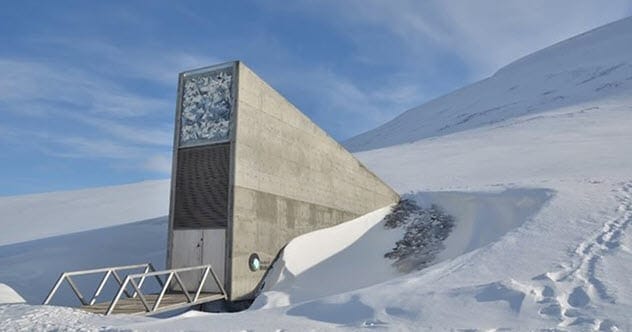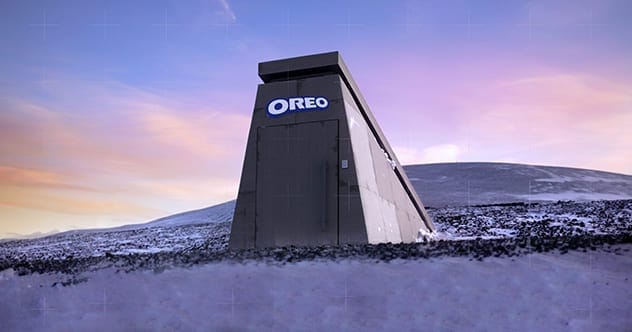Global catastrophes loom large in our collective imagination. From nuclear war to natural disasters, the potential for widespread devastation is a constant concern. But humanity is not entirely unprepared. Across the globe, incredible doomsday vaults have been constructed to safeguard essential resources, cultural heritage, and even a few sweet treats, ensuring that something survives, no matter what.
These vaults, often located in remote and secure locations, represent our best efforts to preserve life and knowledge against the worst possible scenarios. They are testaments to human ingenuity and our enduring hope for the future.
1. Svalbard Global Seed Vault

Located on the remote Svalbard islands of Norway, the Svalbard Global Seed Vault (SGSV) is perhaps the most well-known doomsday vault. Deep inside a mountain, it houses over 1.5 billion seeds from nearly every country in the world. This “Noah’s Ark” for plants is designed to withstand natural disasters and even nuclear war, ensuring the survival of global agriculture.
The vault’s location in the Arctic permafrost provides natural refrigeration, further securing the seeds’ longevity. It serves as a crucial backup against the loss of plant species due to climate change, natural disasters, and other threats.
2. Chang La Vault
High in the Himalayas, the Chang La Vault (CLV) in India offers another layer of protection for global crops. This vault stores over 10,000 seeds and 200 plant species, preserved in permafrost at -18 degrees Celsius. Its remote location and high altitude make it resistant to many threats, including earthquakes and floods.
What sets the CLV apart is its focus on genetically modified seeds designed to thrive in challenging conditions, such as high altitudes, salty water, and extreme temperatures. This ensures that future generations can cultivate food even in the face of environmental changes.
3. Underground Lunar Vault

Taking the concept of a doomsday vault to the extreme, scientists have proposed building an underground vault on the moon. This “global insurance policy” would store seeds and stem cells at incredibly low temperatures, protected from solar radiation, temperature changes, and micrometeorites.
While still a concept, the lunar vault highlights the lengths to which we might go to preserve life on Earth. It would require significant advancements in cryo-robotics and numerous rocket launches, but the potential payoff is immense.
4. U.S. National Center for Genetic Resources Preservation
Located at Colorado State University, the United States National Center for Genetic Resources Preservation (NCGRP) safeguards over 600,000 seed packets. Stored at freezer-like temperatures, these seeds represent a diverse collection of plant species. The center uses advanced technology, including bar-coding and a secure database, to manage and identify each seed.
The NCGRP also conducts research on seed longevity, storage practices, and seed development, ensuring that it is always ready to respond to a doomsday scenario.
5. Millennium Seed Bank Partnership
The Millennium Seed Bank Partnership (MSBP) focuses on preserving seeds from plants threatened with extinction and those likely to be valuable in the future. This global initiative, involving over 100 countries, has already banked approximately 15.6% of the planet’s wild plant species.
The MSBP’s projects include conserving trees, wild plants, and crops that can withstand climate change. By safeguarding 2.4 billion seeds from around the world, the MSBP plays a crucial role in protecting plant biodiversity.
6. SVF Foundation
Preservation isn’t limited to plants. The SVF Foundation preserves animals by freezing their sperm and embryos. Their cryopreservation program contains 45,000 semen and embryo samples from 20 breeds of rare cattle, sheep, and goats, stored in liquid nitrogen at -312 degrees.
In the event of a catastrophe, these frozen embryos can be used to revive endangered breeds and ensure the survival of livestock.
7. Frozen Zoo
The San Diego Zoo’s Frozen Zoo preserves rare animal hides and cells, leveraging stem cell technology to save animals facing extinction. With samples from over 8,400 species, including Gobi bears, mountain gorillas, and pandas, the Frozen Zoo offers a unique opportunity to recover long-dead animals and reverse extinction.
By transforming skin cells into induced pluripotent stem cells, scientists can produce sperm and egg cells, creating embryos and potentially repopulating endangered species.
8. Arctic World Archive
The Arctic World Archive (AWA) focuses on preserving humanity’s cultural legacy. Located in a decommissioned coal mine on the island of Spitsbergen, the AWA contains 21 terabytes of open-source code representing the world’s most cherished works of art, literature, and religion.
The source code is preserved on high-resolution photosensitive reels of film, designed to last 500 years. Instructions on each reel explain how to convert the QR codes into usable files, ensuring that future generations can access and enjoy our cultural heritage.
9. Global Microbiota Vault
Recognizing the importance of good microbes for human health, Rutgers University researchers have proposed the creation of a Global Microbiota Vault (GMV). This vault would store and preserve beneficial microbes, which play a critical role in digestion and immune system function.
The GMV would be located in a politically neutral country to encourage global contributions, ensuring a diverse and comprehensive collection of microbes. By safeguarding these essential microorganisms, the GMV would protect human health in the event of a doomsday scenario.
10. Global Oreo Vault
Even in the face of global catastrophe, sometimes you just need a cookie. The Global Oreo Vault is designed to resemble the Svalbard Global Seed Vault, protecting packaged Oreos wrapped in mylar, which can withstand extreme temperatures and environmental conditions.
Completed in 30 days, this whimsical project ensures that the recipe for Oreos and a stockpile of cookies will be available after any apocalypse. It is a fun reminder that even in the darkest of times, a little bit of sweetness can go a long way.
Conclusion
From seeds and embryos to cultural artifacts and cookies, doomsday vaults represent humanity’s commitment to survival and the preservation of our world. These incredible facilities, located in remote and secure locations, offer hope for the future, ensuring that something of our world will endure, no matter what.
What do you think about these Doomsday Vaults? Let us know by leaving a comment below!










